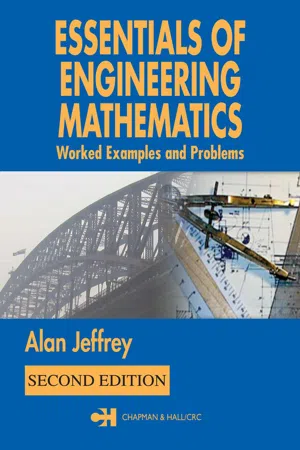
This is a test
- 896 pages
- English
- PDF
- Available on iOS & Android
eBook - PDF
Essentials Engineering Mathematics
Book details
Table of contents
Citations
About This Book
First published in 1992, Essentials of Engineering Mathematics is a widely popular reference ideal for self-study, review, and fast answers to specific questions. While retaining the style and content that made the first edition so successful, the second edition provides even more examples, new material, and most importantly, an introduction to usi
Frequently asked questions
At the moment all of our mobile-responsive ePub books are available to download via the app. Most of our PDFs are also available to download and we're working on making the final remaining ones downloadable now. Learn more here.
Both plans give you full access to the library and all of Perlego’s features. The only differences are the price and subscription period: With the annual plan you’ll save around 30% compared to 12 months on the monthly plan.
We are an online textbook subscription service, where you can get access to an entire online library for less than the price of a single book per month. With over 1 million books across 1000+ topics, we’ve got you covered! Learn more here.
Look out for the read-aloud symbol on your next book to see if you can listen to it. The read-aloud tool reads text aloud for you, highlighting the text as it is being read. You can pause it, speed it up and slow it down. Learn more here.
Yes, you can access Essentials Engineering Mathematics by Alan Jeffrey in PDF and/or ePUB format, as well as other popular books in Mathematics & Applied Mathematics. We have over one million books available in our catalogue for you to explore.
Information
Table of contents
- Front Cover
- Contents
- Preface
- Section 1: Real numbers, inequalities and intervals
- Section 2: Function, domain and range
- Section 3: Basic coordinate geometry
- Section 4: Polar coordinates
- Section 5: Mathematical induction
- Section 6: Binomial theorem
- Section 7: Combination of functions
- Section 8: Symmetry in functions and graphs
- Section 9: Inverse functions
- Section 10: Complex numbers: real and imaginary forms
- Section 11: Geometry of complex numbers
- Section 12: Modulus–argument form of a complex number
- Section 13: Roots of complex numbers
- Section 14: Limits
- Section 15: One- sided limits: continuity
- Section 16: Derivatives
- Section 17: Leibniz's formula
- Section 18: Differentials
- Section 19: Differentiation of inverse trigonometric functions
- Section 20: Implicit differentiation
- Section 21: Parametrically defined curves and parametric differentiation
- Section 22: The exponential function
- Section 23: The logarithmic function
- Section 24: Hyperbolic functions
- Section 25: Inverse hyperbolic functions
- Section 26: Properties and applications of differentiability
- Section 27: Functions of two variables
- Section 28: Limits and continuity of functions of two real variables
- Section 29: Partial differentiation
- Section 30: The total differential
- Section 31: The chain rule
- Section 32: Change of variable in partial differentiation
- Section 33: Antidifferentiation (integration)
- Section 34: Integration by substitution
- Section 35: Some useful standard forms
- Section 36: Integration by parts
- Section 37: Partial fractions and integration of rational functions
- Section 38: The definite integral
- Section 39: The fundamental theorem of integral calculusand the evaluation of definite integrals
- Section 40: Improper integrals
- Section 41: Numerical integration
- Section 42: Geometrical applications of definite integrals
- Section 43: Centre of mass of a plane lamina (centroid)
- Section 44: Applications of integration to he hydrostatic pressure on a plate
- Section 45: Moments of inertia
- Section 46: Sequences
- Section 47: Infinite numerical series
- Section 48: Power series
- Section 49: Taylor and Maclaurin series
- Section 50: Taylor's theorem for functions of two variables: stationary points and their identification
- Section 51: Fourier series
- Section 52: Determinants
- Section 53: Matrices: equality, addition, subtraction, scaling and transposition
- Section 54: Matrix multiplication
- Section 55: The inverse matrix
- Section 56: Solution of a system of linear equations: Gaussian elimination
- Section 57: The Gauss–Seidel iterative method
- Section 58: The algebraic eigenvalue problem
- Section 59: Scalars, vectors and vector addition
- Section 60: Vectors in component form
- Section 61: The straight line
- Section 62: The scalar product (dot product)
- Section 63: The plane
- Section 64: The vector product (cross product)
- Section 65: Applications of the vector product
- Section 66: Differentiation and integration of vectors
- Section 67: Dynamics of a particle and the motion of a particle in a plane
- Section 68: Scalar and vector fields and the gradient of a scalar function
- Section 69: Ordinary differential equations: order and degree, initial and boundary conditions
- Section 70: First order differential equations solvable by separation of variables
- Section 71: The method of isoclines and Euler’s methods
- Section 72: Homogeneous and near homogeneous equations
- Section 73: Exact differential equations
- Section 74: The first order linear differential equation
- Section 75: The Bernoulli equation
- Section 76: The structure of solutions of linear differential equations of any order
- Section 77: Determining the complementary function for constant coefficient equations
- Section 78: Determining particular integrals of constant coefficient equations
- Section 79: Differential equations describing oscillations
- Section 80: Simultaneous first order linear constant coefficient differential equations
- Section 81: The Laplace transform and transform pairs
- Section 82: The Laplace transform of derivatives
- Section 83: The shift theorems and the Heaviside step function
- Section 84: Solution of initial value problems
- Section 85: The delta function and its use in initial value problems with the Laplace transform
- Section 86: Enlarging the list of Laplace transform pairs
- Section 87: Symbolic algebraic manipulation by computer software
- Answers
- Reference information